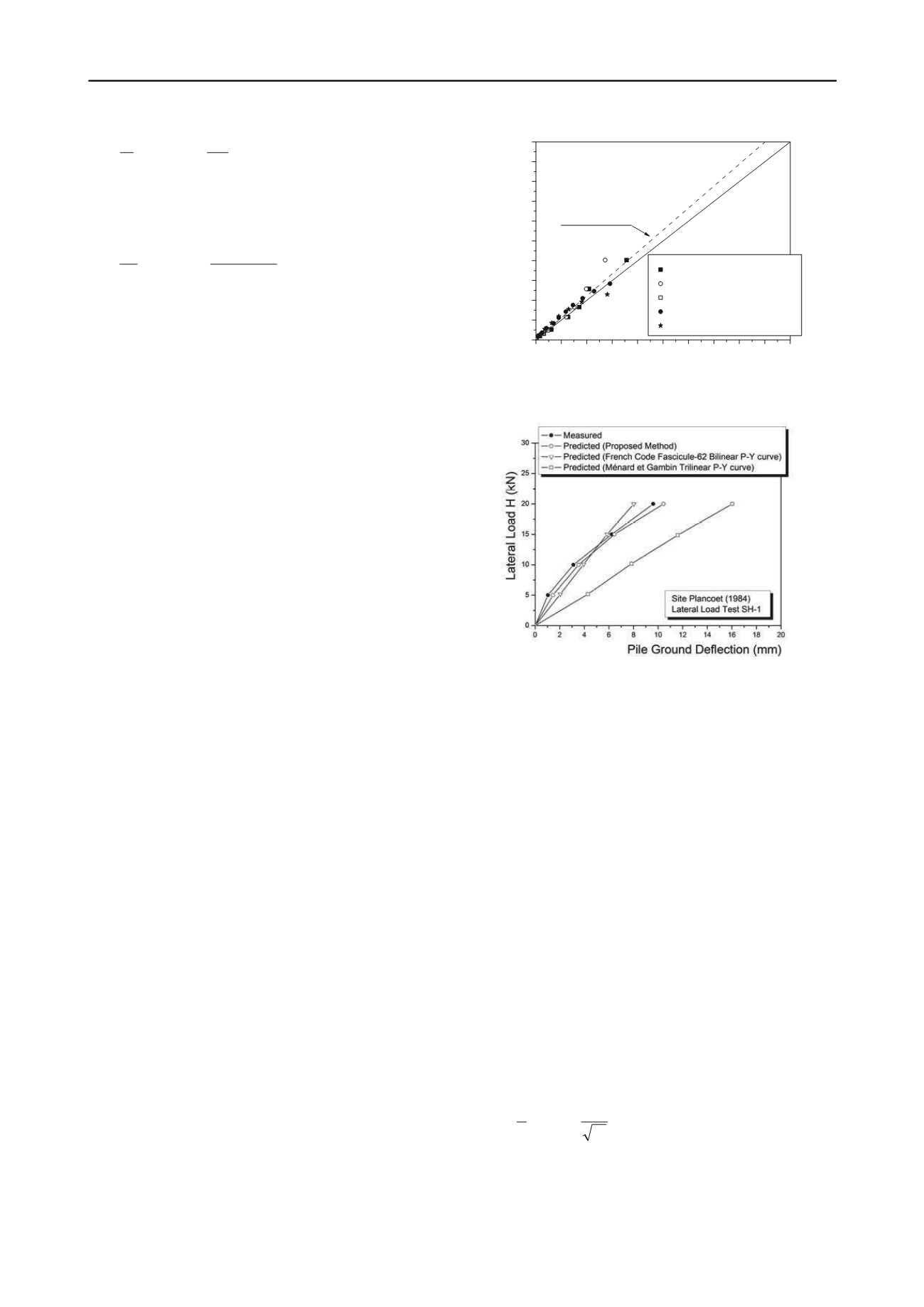
2697
Technical Committee 212 /
Comité technique 212
i
M
i
E
M
i
i
E
ti
i
i
ti
EK dz z E
h
K dz zE
h
E
)(
)(
1
(15)
8. Compute E
ti
c
according to equation 12 as follows:
e
ni
i
i
i
M
i
E
D
ti
e
c
ti
D
hEK
dz zE
D
E
e
1
0
)(
1
(
16)
9. Compute the transfer length L
0
by equation 11.
10. Compute the effective embedded length D
e
of the pile based
on equation 10. If L
0
leads to D>D
e
(flexible pile), repeat steps 4
to 10 along an iterative process until the convergence of K
R
.
11. Compute the values of E
ti
and P
u
for each segment according
to equations (3) and (4) respectively.
12. Use a PC software to analyze the load-deflection response
of the pile on the basis of the P-Y curves so built. SPULL
(Single Pile Under Lateral Loads) developed at the University
of Blida is a freeware available upon request sent by E-mail to
the author.
4 VALIDATION OF THE METHOD
Lateral load-deflection response of some case studies reported
in the literature was predicted. Piles are identified as mentioned
in their references.
Five full-scale lateral loading tests in sandy soils were
studied according to the proposed method.
The Lock & Dam 26 site is composed of alluvial deposits
(poorly graded sand) 3 m thick and overlying glacial deposits
(medium to coarse sand with gravel) 17 m thick. The bedrock is
a hard limestone from the Mississipian age. Lateral load tests
were performed on two identical HP-14x73 piles socketed in the
limestone bedrock, jacked apart, and the lateral displacements
of each pile were measured.
The Longjuemau site is located near Paris and composed of a
tertiary silty fine sand, rather uniformly graded. Piles TG and
TD are driven and loaded as in the above site.
The Roosevelt bridge site is composed of loose layer of sand
thick of 4 m, overlying a thick layer of very dense partially
cemented sand. The site was submerged by water up to 2 m
above the ground level. Square prestressed concrete pile was
driven and tested up to cracking under a load of 200 kN and
concrete failure occurred under a load of 320 kN.
Figure 2 shows remarkable fluctuation of the 35 points of
comparison around the ratio predicted to measured ground
deflection of 1.11. Moreover, Y
0
pred.
/Y
0
meas.
has a mean value of
1.22 and a coefficient of variation of 21%.
The experimental site located in Plancoët (Côtes-du-Nord,
France) is a bi-layered soil composed of a clay (CL) thick of 4
m overlying a layer of sand (SM) thick of 4 m. The test pile is a
driven rectangular pipe with 0.284 m of width and an embedded
length of 6.5 m.
As shown in figure 3, very good agreement is noticed
between the measured pile ground deflections and the ones
predicted by the proposed method. The P-Y curves of Ménard
and Gambin led to very pessimistic prediction (Hadjadji et al,
2002). The P-Y curves of the French code Fascicule-62
however overpredicted at small deflections and then
underpredicted at larger deflections (Hadjadji et al, 2002).
Moreover, two other multi-layered experimental sites were
studied.
Figure 2. Comparison of predicted and measured deflections in sand
0 5 10 15 20 25 30 35 40 45 50
0
5
10
15
20
25
30
35
40
45
50
Y
0
/B predicted %
Y
0
/B measured %
Lock & Dam, Pile 3-12
Lock & Dam, Pile 3-13
Roosevelt bridge, Pile 16
Longjumeau, Pile TG
Longjumeau, Pile TD
Y
pred.
0
/Y
meas.
0
=1,11
(R
2
=94%)
Figure 3. Comparison of predicted and measured deflections in
bilayered soil
The first one is located in Vallée de Voulzie (Provins,
France) and composed of 14 m de silt overlying 2.5 m of
gravelly sand and then a layer of soft chalk becoming hard in
depth. The test pile is a vibratory driven pipe having an outside
diameter of 0.93 m and an embedded length of 23 m.
The second site is located in Livry-Gargan (France) and
composed of clayey sand thick of 4 m, followed by a layer of
marl thick of 10 m then a deep layer of chalk. The test pile is a
bored pipe having an outside diameter of 0.7 m and an
embedded length of 20 m (Moussard and kersale, 2011).
As illustrated by figure 4, the pile ground deflections were
accurately predicted by the proposed method. The results of
of
f the
Equation 6 may be reformulated in case of a solid circular pile
embedded in a homoge
combining equations 6 and
predictions are encouraging seeing the multitude
approximations made during the process of definition o
method.
5 ANALYSIS OF THE FEATURES OF THE METHOD
5.1. The modulus number
neous soil. For example, in sandy soils,
8 leads to:
K
BD K
E
1 ) / (
2
3
2
(17)
where K = E
p
/E
c
is the pile/soil compressibility. This equation
shows that the modulus number increases with the pile
slenderness ratio and decreases with the pile/soil
compressibility.


